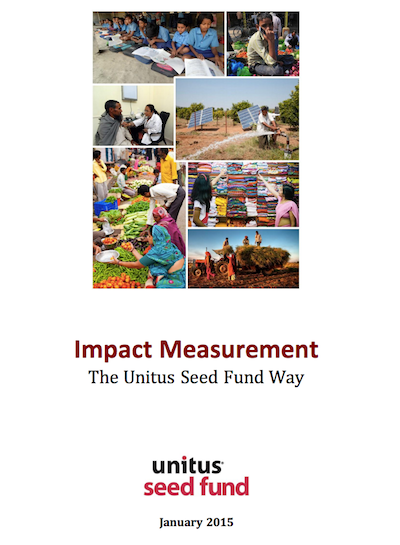Finding Realistic Impact Measures for Investors, Entrepreneurs: Presenting Unitus Seed Fund’s new guide for measuring impact
Measuring the impact of investments is a young and developing area, and techniques for measuring impact on very early-stage companies are particularly nascent. Unitus Seed Fund’s new guide, Impact Measurement: The Unitus Seed Fund Way, has combined the methodology and approach we applied to designing an impact measurement framework. It consists of templates that can be downloaded for use, organized by sector and applicable to businesses ranging from health care and agriculture to mobile commerce and retail. Among the many players in the poverty alleviation ecosystem, the guide can be applied to the following:
- Very early-stage to growth stage companies with built-in impact
- Social enterprises, and
- Nonprofits with limited resources for an evaluation.
We’ve shared thoughts about current state-of-the-art approaches in impact assessment and reporting from two perspectives:
- First, for entrepreneurs to help them think about the value of impact assessment in their business operations, and
- Second, for entrepreneurs and investors, to understand how assessments and reporting of impact can apply to companies and sectors at the level of a private equity fund such as Unitus Seed Fund.
We start off by discussing the recent concept of “mission drift” as observed in the microfinance industry, where some MFIs started to scale very fast, with a percentage of loans not being used productively. The same concept is repurposed for impact ventures, where a drift detected early on by companies and investors can help them refine their model moving forward. We then go on to explore where and how impact data can be utilized by businesses.
At Unitus Seed Fund, our approach to analyzing impact data begins with examining impact measurement frameworks based on two objectives:
- Metrics should add value to business operations for the fund and its portfolio companies, and
- Metrics should make us accountable and transparent to investors about the social and financial impact created.
 Considering early-stage businesses’ lack of human and financial resources to invest in measurement, we designed a right-sized adaptive framework by collaborating with entrepreneurs. It’s important to identify metrics that can be tied directly into business operational and strategic decisions. Presuming that social impact is built into the business model, having a small number of easily-tracked metrics that help demonstrate if your implementation model is working should facilitate building systems for impact data collection. It is also imperative to find realistic and measurable indicators that can be affordably tracked over time, and that align with the vision for desired impact.
Considering early-stage businesses’ lack of human and financial resources to invest in measurement, we designed a right-sized adaptive framework by collaborating with entrepreneurs. It’s important to identify metrics that can be tied directly into business operational and strategic decisions. Presuming that social impact is built into the business model, having a small number of easily-tracked metrics that help demonstrate if your implementation model is working should facilitate building systems for impact data collection. It is also imperative to find realistic and measurable indicators that can be affordably tracked over time, and that align with the vision for desired impact.
We customized the logical framework approach, commonly used in evaluation design, to suit the impact ecosystem. The guide highlights two important concepts to consider while designing the measurement framework: first, to be adaptive to the stage of the company by considering its evolution in impact and availability of resources from seed-stage to growth; and second, to be lean in structure by keeping the metrics to a minimum, and to integrate technology to minimize data collection systems.
Unitus Seed Fund’s guide includes a common set of metrics that can be applied to any other venture fund. These metrics are detailed with definitions and needs that apply across sectors, with output and outcome level metrics available for different types of businesses to download and use. For more information, please read Impact Measurement: The Unitus Seed Way.
Uma Sekar is the Impact Assessment Intern at the Unitus Seed Fund.
- Categories
- Impact Assessment
